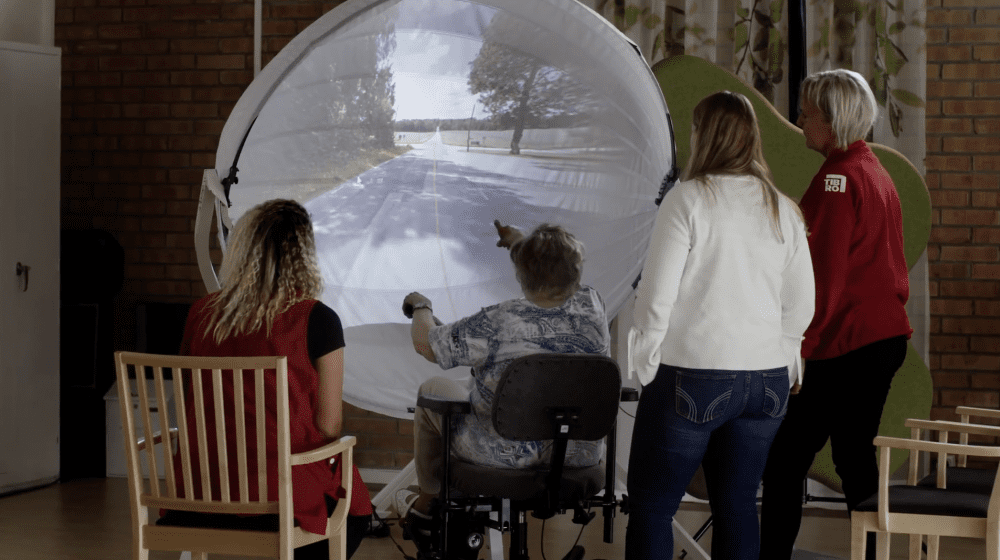
A specially developed exercise bike uses Google Street View to allow people living with dementia to visit – virtually – places from their past or places they are interested in.
BikeAround is has been designed for people living with dementia, a condition for which there is no cure. With someone diagnosed with dementia every 3 seconds, the issue of dementia is a global phenomenon – and it is growing. Ageing populations in most of the developed work will mean the number of people diagnosed with dementia will rise.
The technology has been developed by Swedish robotics company, Camanio Care, and helps people living with dementia to rekindle memories, have better conversations, develop social connections, build physical strength, and sleep better.
Cecilia Larsson, Key Account Manager with Camanio Care, told HelloCare that BikeAround uses the ‘reminiscence method’ to help people who are living with dementia.
“You can travel in well known environments which can make you remember things from your life,” she said.
“You have a moment when you remember things and you’re not suffering from memory loss,” says one of BikeAround’s inventors, Anne-Christine Hertz.
Ms Larsson said popular places to visit are where you lived as a child, where your grandparents lived, your church, or a place you liked to visit in the past.
The benefits of BikeAround have been immediately apparent for those who have tried it.
“It meets a number of needs and you get a both direct and long term positive outcomes, both physically and mentally,” said Ms Larsson.
BikeAround is designed to be used as a small group, with one person pedalling – usually the person who is living with dementia – and either family or carers, or both, nearby to talk about what the rider is seeing.
If the user is not able to actually use the pedals, therapists or family can guide them using the software to have the same experience.
“The social aspect is a big part [of BikeAround] and the person using the bike should be accompanied by a staff member, next of kin, or even both,” said Ms Larsson. The developers at Camanio have devised a number of questions carers can ask, and ideas for where to travel to help guide the experience if necessary.
“It often makes the user start talking, and staff or next of kin can ask questions about where they are, or if they have any special memories connected to that place.”
The language benefits have been notable. One observer noted that the person riding had “more accurate word finding when conversing regarding her home” while on BikeAround.
Relationships are strengthened. BikeAround encourages conversation between people in the facility, within families, and even between strangers.
The length of therapy sessions tended to increase because the patient is enjoying the experience. One carer said the patient “enjoyed showing the therapist his neighbourhood” to such an extent that therapy sessions extended from the usual 10 minutes to 25 minutes.
The pedalling helps someone who might have difficulties moving around or walking to be more mobile. Users are calmer and sleep better, said Ms Larssen.
The feedback from users has been “very positive”, said Ms Larsson.
Larsson said one elderly lady who rarely spoke, now gets up early in the morning, before anyone else is awake at the care home where she lives, and bikes to her childhood village. She speaks more now and seems more content.
One user “enjoyed pedalling around his favourite major league baseball stadium”, and other was “very engaged in pathfinding and talking about his home in California.”
BikeAround has gained attention from all over the world, in part because it provides a global solution to a global problem.
“Dementia is a global problem, and we are providing a tool that is globally fitted from start,” said Ms Larsson.
“Since our software are using the pictures from Google Street View, most of the world is available instantly, with no need for the product to be locally adjusted.”
There are two versions of the product – either with a flat screen, or with a domed screen for a more interactive experience.
BikeAround is already talking to interested companies about introducing the product in Australia “very soon”, said Ms Larssen.
Professor Ralph Maddison at the Institute for Physical Activity and Nutrition (IPAN) at Deakin University is undergoing a large research project on the technology.